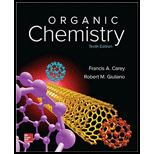
Concept explainers
Interpretation:
The structures for the compounds A and B that are produced in the photochemical chlorination of the given alkane are to be deduced and the factors that influencing their distribution are to be discussed.
Concept introduction:
If the hydrogens in
Among alkanes, tertiary hydrogens are replaced faster than secondary, and secondary faster than primary.
The ratio of the monochlorination products depends on the type of hydrogen that is abstracted by the chlorine atom and the free radical that is formed.
In
Want to see the full answer?
Check out a sample textbook solution
Chapter 10 Solutions
ORGANIC CHEMISTRY (LL)-W/SOLN.>CUSTOM<
- Under milder temperatures than what is needed for dehydration, strong acids catalyze the self-condensation of 1-propyl alcohol to give di-n-propyl ether. The mechanism differs from that of today's reaction in that the protonated alcohol undergoes an Sn2 rather than an Sn1 reaction. Write the mechanism for the acid catalyzed condensation of ethyl alcohol to give diethyl ether. Make sure the mechanism includes protonation, Sn2, and deprotonation.arrow_forward3-Chloro-2-methylpropene reacts with sodium methoxide in methanol to form 3-methoxy-2-methylpropene. For each of the following changes in the reaction conditions, state whether the reaction rate would increase, decrease, or remain the same. Explain your reasoning. In some cases the identity of the major organic product would be expected to change; in such cases, give the expected major product. (a) the same quantities of reagents are dissolved in half the volume of methanol (b) 3-bromo-2-methylpropene is used in place of 3-chloro-2-methylpropene (c) sodium methanethiolate (CH3SNa) is used in place of of sodium methoxidearrow_forwardWrite the mechanism and predict the product for the reaction of cyclohexene with bromine. Make sure that you include the stereochemistry for the reaction in your mechanism. Then describe in detail the appearance of the reactants and products in this reaction. What would be the visible evidence that a reaction took place? Explain paragraph why no color change would occur upon mixing cyclohexanol with a solution of bromine.arrow_forward
- Isoprene has sometimes been used as a starting material in the laboratory synthesis of terpenes. In one such synthesis, the first step is the electrophilic addition of 2 mol of hydrogen bromide to isoprene to give 1,3-dibromo-3-methylbutane.Write a series of equations describing the mechanism of this reaction.arrow_forwardWrite the reaction mechanism between ethane and chlorine in the presence of light. Label each step and give a brief explanation.arrow_forward3-Chloro-2-methylpropene reacts with sodium methoxide in methanol to form 3-methoxy-2-methylpropene. For each of the following changes in the reaction conditions, state whether the reaction rate would increase, decrease, or remain the same. Explain your reasoning. In some cases the identity of the major organic product would be expected to change; in such cases, give the expected major product. (a) dimethyl sulfoxide (DMSO) is used in place of methanol (b) methanol is used by itself without sodium methoxide (c) 1-chloro-2,2,-dimethylpropane is used in place of 3-chloro-2-methylpropenearrow_forward
- Two substitution products result from the reaction between 3-chloro-3-methyl-1- butene with sodium acetate (CH3COO – Na +) in acetic acid under SN1. Identify the products.arrow_forwardIn most instances hydrolysis of an alkylhalide is catalyzed by hydroxide ion. However, the rate of hydrolysis of t-butyl chloride in aqueous ethanol is almost unaffected by addition of potassium hydroxide. Suggest a reason for this and explain why this effect is observed with a t-butyl compound. Illustrate your answer.arrow_forwardEthers can be prepared by reaction of an alkoxide or phenoxide ion with a primary alkyl halide. Draw the structure of the expected organic product of the reaction of iodoethane with the following alkoxide ion: H3C CH3 + Na You do not have to consider stereochemistry. You do not have to explicitly draw H atoms. Do not include lone pairs in your answer. They will not be considered in the grading. • Do not include counter-ions, e.g., Na", I, in your answer. P opy aste [*arrow_forward
- Ozonolysis process was carried out towards an unknown organic compound, X, to produce propanal, C3H6O and compound Y. Propanal was then further oxidized into compound Z, C3H6O2 by using potassium permanganate, KMnO4 under acidic condition and heating. As an alternative, compound Y can be produced from the reaction of benzene with ethanoyl chloride, CH3COCl with the presence of aluminium trichloride, AlCl3. (i) Draw the structural formula of compounds X, Y, and Z (ii) Show the formation of electrophile that will be reacted with benzene for the formation of compound Y. (iii) What is the name of reaction to convert benzene into compound Y?arrow_forwardWhen exactly 1 mole of methane is mixed with exactly 1 mole of chlorine and light is shone on the mixture, a chlorination reaction occurs. The products are found to contain substantial amounts of di-, tri-, and tetrachloromethane, as well as unreacted methane. Explain how a mixture is formed from this stoichiometric mixture of reactants, and propose mechanisms for the formation of these compounds from chloromethane.arrow_forwardWhat is the function of CH2Cl2 in the bromination reactions? Why can it fulfil this rolearrow_forward
 ChemistryChemistryISBN:9781305957404Author:Steven S. Zumdahl, Susan A. Zumdahl, Donald J. DeCostePublisher:Cengage Learning
ChemistryChemistryISBN:9781305957404Author:Steven S. Zumdahl, Susan A. Zumdahl, Donald J. DeCostePublisher:Cengage Learning ChemistryChemistryISBN:9781259911156Author:Raymond Chang Dr., Jason Overby ProfessorPublisher:McGraw-Hill Education
ChemistryChemistryISBN:9781259911156Author:Raymond Chang Dr., Jason Overby ProfessorPublisher:McGraw-Hill Education Principles of Instrumental AnalysisChemistryISBN:9781305577213Author:Douglas A. Skoog, F. James Holler, Stanley R. CrouchPublisher:Cengage Learning
Principles of Instrumental AnalysisChemistryISBN:9781305577213Author:Douglas A. Skoog, F. James Holler, Stanley R. CrouchPublisher:Cengage Learning Organic ChemistryChemistryISBN:9780078021558Author:Janice Gorzynski Smith Dr.Publisher:McGraw-Hill Education
Organic ChemistryChemistryISBN:9780078021558Author:Janice Gorzynski Smith Dr.Publisher:McGraw-Hill Education Chemistry: Principles and ReactionsChemistryISBN:9781305079373Author:William L. Masterton, Cecile N. HurleyPublisher:Cengage Learning
Chemistry: Principles and ReactionsChemistryISBN:9781305079373Author:William L. Masterton, Cecile N. HurleyPublisher:Cengage Learning Elementary Principles of Chemical Processes, Bind...ChemistryISBN:9781118431221Author:Richard M. Felder, Ronald W. Rousseau, Lisa G. BullardPublisher:WILEY
Elementary Principles of Chemical Processes, Bind...ChemistryISBN:9781118431221Author:Richard M. Felder, Ronald W. Rousseau, Lisa G. BullardPublisher:WILEY





